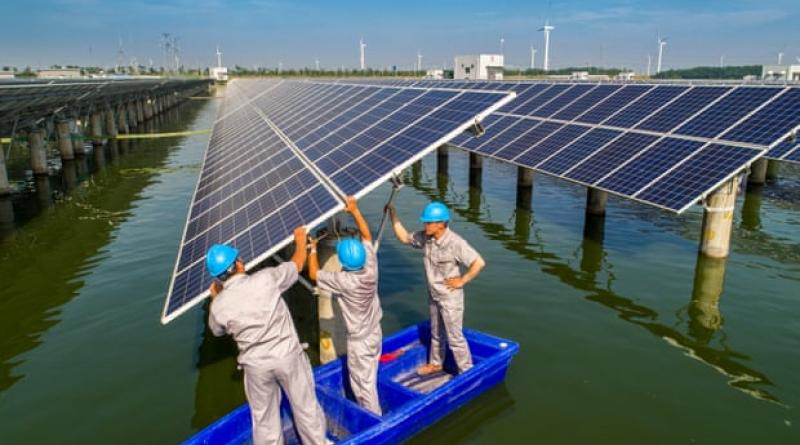China's carbon pledge will require complete inversion of existing system.

Country will need to kick addiction to coal and build eye-watering amount of wind and solar capacity.
China’s President Xi Jinping stunned climate action observers in a speech at the United Nations general assembly last week with a pledge to reach “peak carbon” before 2030, and drive down emissions to virtually zero by 2060.
The pledge from the world’s biggest climate polluter is considered by environmentalists to be the most important step in tackling the climate crisis since the Paris Climate Agreement galvanised global governments to reduce carbon emissions in an attempt to cap global heating well below 2 degrees C above pre-industrialisation levels.
As the world’s largest consumer of coal and the second largest consumer of oil – behind the US – China produces more than a quarter of the world’s annual carbon emissions.
The Climate Action Tracker research consortium has calculated that if China succeeds, its ambitions would effectively shave 0.2 to 0.3°C from global heating forecasts for 2100, down to around 2.4 to 2.5°C above pre-industrialised levels. This is still well above the 1.5˚C heating limit that the signatories of the 2015 Paris agreement had hoped to achieve, but it is a step closer.
Jennifer Morgan, executive director of Greenpeace International, said China’s commitment to go carbon neutral before 2060 “sends a strong signal that the reality of the climate crisis”.
“However, actions speak louder than words,” she said. “There are two key questions next: how will China ensure that its actions match its commitments? And second, will Washington join in?”
China’s pledge emerged days after the EU toughened its own 2030 climate targets, raising the chances of a powerful economic coalition between the two that would cover a third of the world’s carbon emissions.
It sends a pointed geopolitical message to the US, now the only major polluting country which has yet to set a target to end its contribution to the climate crisis and coming as the US president, Donald Trump, prepares to pull out of the Paris Climate Agreement in November.
China offered no details of how it would achieve the ambitious carbon-neutral target, but the action required would set in motion powerful geopolitical and economic shifts which hold important implications for the future of fossil fuels, low-carbon technologies and climate diplomacy.
The single largest reduction in emissions on record would require nothing less than a complete inversion of China’s existing energy system, one that promises to reverberate across global energy markets.
Today, fossil fuels account for about 85% of China’s energy mix, and renewable energy makes up 15%. It is likely that these proportions would need to flip by 2060 to achieve carbon neutrality. This would call for the world’s fastest-growing economy to kick its addiction to coal and accelerate its clean energy investments at a pace few had dared believe was possible.
The largest challenge for China will be its growing number of coal-fired power plants. China consumes around half of the global supply to power its coal-fired plants. Its government set targets allowing another 60 GW of coal-fired projects to go into operation. It has more than 250 GW of new capacity either proposed or under construction.
“Coal is the highest-emitting fuel and by far the largest source of primary demand in China, and will feel the greatest impact from this policy,” said analysts at S&P Global’s Platts Analytics team.
“The magnitude of the needed reductions will be dramatic,” the analysts added, but it would be “tempered” if China could bring in carbon-capture technology, which uses carbon offsets – such as tree planting – or manages to reduce emissions from sectors outside energy sector.
China will also need to rethink its growing reliance on oil, according to Platts. The analysts that a “mass electrification of transportation” would need to be accelerated alongside using clean-burning green hydrogen as a fuel in a key sectors.
XI Nan, an analyst at Rystad Energy, said the “unexpected, ambitious” plan would require “massive policy support” to bring forward clean energy investment and further clarity on the government’s plans for developing carbon-capture technology and carbon-offset credits.
China-based Industrial Securities Co predicts that the government’s pursuit of low-carbon energy will focus on renewable electricity from windfarms and solar panels rather than nuclear reactors or biofuel options.
It has estimated that meeting the new target will require eye-watering amounts of both. In a note late last week, the securities companies estimated that China would require between 80GW to 115GW of new solar to be installed every year to meet the target, as well as an annual increase of 36GW to 45GW of wind power. This comes on top of China’s existing 241 GW of wind power capacity and 180GW of utility-scale solar power.
By contrast, the UK government’s independent climate advisers at theCommittee on Climate Change have suggested that Britain should aim to roll out between 22 to 29 GW of onshore wind capacity and 23 to 43 GW of solar by 2030, and 75 GW of offshore wind in 2050.
The scale of China’s renewable energy bonanza holds the potential for further cost-cutting in renewable energy and battery technology, and may spark even larger cost-cutting in newer, low-carbon solutions including hydrogen production and carbon capture technologies.
The Chinese government is expected to set out further details in its 14th five-year plan next March.
27 September 2020
Τhe Guardian




